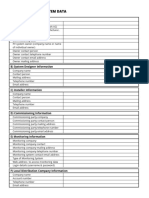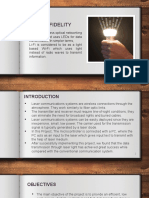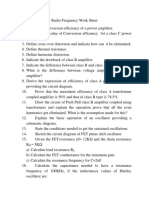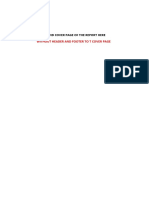Examples
Uploaded by
anjanaExamples
Uploaded by
anjanaExamples:
Oscillators
1. For gm=6000 μS, rd=36 KΩ and Feedback Network Element R=12 KΩ
Select Value of C for Oscillation Frequency of 2.5 KHz and
RD for A>29.
1
fr
2 6 RC
So, Find C Using
Take A = 40 > 29 to find RL from
|A|=gmRL
As get RD from it.
2. Calculate the operating frequency of a BJT phase-shift oscillator as in Fig. for R = 6 kΩ, C= 1500 pF,
and RC =18 kΩ.
Use equation to calculate f.
3. For an FET Colpitts oscillator as in Fig. and the following circuit values determine the Circuit
oscillation frequency:
C1 =750 pF, C2 =2500 pF, and L= 40 H.
Use following equations for calculation,
4. For the transistor Colpitts oscillator of Fig. and the following circuit values, calculate
The oscillation frequency: L=100 H, LRFC =0.5 mH, C1=0.005 F, C2=0.01 F, and CC=10 F.
Use following equations for calculation,
5. Calculate the oscillator frequency for an FET Hartley oscillator as in Fig. for the following circuit
values:
C = 250 pF, L1 = 1.5 mH, L2 = 1.5 mH, and M =0.5 mH.
Use Following Equations for calculation.
6. Calculate the oscillation frequency for the transistor Hartley circuit of Fig. and the following
Circuit values:
LRFC=0.5 mH, L1 =750 H, L2 =750 μH, M =150 μH, and C=150 pF.
Use Following Equations for calculation.
** For Wien Bridge Oscillators, Refer the Solved Examples of Slides.
Power Amplifiers:
1. Calculate the input power, output power and efficiency for the circuit of Fig. The input signal
results in a base current of 5 mA rms.
𝑉𝐶𝐶 −0.7 𝑉
𝐼𝐵𝑄 = = 14.41 mA
𝑅𝐵
𝐼𝐶𝑄 = 𝛽𝐼𝐵𝑄 = 40(14.41 𝑚𝐴) = 0.576 𝐴
𝑉𝐶𝐸𝑄 = 𝑉𝐶𝐶 − 𝐼𝐶 𝑅𝐶 = 18 𝑉 − 0.576(16) = 8.784
𝐼𝐶(𝑝) = 𝛽𝐼𝐵(𝑝) = 40(√2(𝐼𝐵(𝑟𝑚𝑠) ) = 283 𝑚𝐴
2
𝐼𝐶(𝑃)
𝑃0(𝑎𝑐) = 𝑅𝐶 = 0.721 𝑊
2
𝑃𝐼(𝑑𝑐) = 𝑉𝐶𝐶 𝐼𝐶𝑄 = 18(0.576) = 10.368 𝑊
𝑃𝑜(𝑎𝑐) 0.721
% Efficiency 𝜂 = 𝑋100 % = 𝑋100 % = 6.954
𝑃𝐼(𝑑𝑐) 10.368
**Also refer the examples of the Slides of Power Amplifiers, and Solved Examples of
the Chapter 16 – Power Amplifiers (Robert Boylestad)
Transistors at lower frequencies:
Refer the Solved Examples of slides for Transistor at Low Frequency.
FETs
Refer Solved Examples of different Bias Circuits with Mathematical Approach from
Field Effect Transistor Slides.
Find Similar Examples from Chapter 6 – FET Biasing (Robert Boylestad).
Example on Graphical Approach:
1. for the fixed-bias configuration of Fig:
(a) Sketch the transfer characteristics of the device.
(b) Superimpose the network equation on the same graph.
(c) Determine IDQ and VGSQ.
(d) Using Shockley’s equation, solve for IDQ and then find
VGSQ. Compare with the solutions of part (c).
Solution:
Shockley's equation to quickly draw the transfer
characteristics curve
Plot Transfer Curve using the Four Points Obtained.
The fixed level of VGS has to be superimposed as a vertical line a VGS= -VGG
The point where the two curves intersect is the common solution to the configuration Fixed Bias
Configuration commonly referrers to as the quiescent or operating point.
You might also like
- Form 1 - General System Data: A) Basic System Information75% (4)Form 1 - General System Data: A) Basic System Information15 pages
- Objectives Questions (Electronic Devices Circuits (WWW - Egate.ws)0% (1)Objectives Questions (Electronic Devices Circuits (WWW - Egate.ws)11 pages
- Unit 2 Non-Inverting and Inverting AmplifierNo ratings yetUnit 2 Non-Inverting and Inverting Amplifier6 pages
- Electronics Laboratory Simulation of BJT AmplifierNo ratings yetElectronics Laboratory Simulation of BJT Amplifier14 pages
- E7 Data and Results Put Relaxation Oscillator NuisaNo ratings yetE7 Data and Results Put Relaxation Oscillator Nuisa9 pages
- Logic Families: Ics, Logical Operation Operational PropertiesNo ratings yetLogic Families: Ics, Logical Operation Operational Properties33 pages
- Analog and Digital Signal Processing Lab TaskNo ratings yetAnalog and Digital Signal Processing Lab Task10 pages
- Ideal Operational Amplifier and Its Caracteristics100% (1)Ideal Operational Amplifier and Its Caracteristics11 pages
- EE2010Notes+Tutorials of PartI (For EEE Club)No ratings yetEE2010Notes+Tutorials of PartI (For EEE Club)118 pages
- Activity No. 8 Impedance of Inductance, Resistance and Capacitance CircuitNo ratings yetActivity No. 8 Impedance of Inductance, Resistance and Capacitance Circuit5 pages
- Experiment No. 13: Objective: To Investigate The Use of JFET As A Constant Current Source & As Chopper ApparatusNo ratings yetExperiment No. 13: Objective: To Investigate The Use of JFET As A Constant Current Source & As Chopper Apparatus3 pages
- Simulation of Closed Loop Control of Buck Converter Fed DC Motor DriveNo ratings yetSimulation of Closed Loop Control of Buck Converter Fed DC Motor Drive4 pages
- 9-Frequency Spectrum, Power relation-17-Dec-2019Material - I - 17-Dec-2019 - Extract - Pages - From - 2 PDFNo ratings yet9-Frequency Spectrum, Power relation-17-Dec-2019Material - I - 17-Dec-2019 - Extract - Pages - From - 2 PDF10 pages
- Electronic Devices and Circuit Theory 11th Edition Boylestad Robert Nashelsky Louis 2024 scribd download83% (6)Electronic Devices and Circuit Theory 11th Edition Boylestad Robert Nashelsky Louis 2024 scribd download55 pages
- ECE 027 - Simulation Activity 2.1 The Zener and Light Emitting DiodeNo ratings yetECE 027 - Simulation Activity 2.1 The Zener and Light Emitting Diode8 pages
- ELEN 30083 Electrical Machines 1: Prepared byNo ratings yetELEN 30083 Electrical Machines 1: Prepared by45 pages
- Transistor at Low and High Frequencies - EDC - Unit 3 PDFNo ratings yetTransistor at Low and High Frequencies - EDC - Unit 3 PDF102 pages
- Karan Kishore Final Year Internship ReportNo ratings yetKaran Kishore Final Year Internship Report32 pages
- Safety Considerations of Wireless Charger For EV100% (1)Safety Considerations of Wireless Charger For EV11 pages
- 0.5-8 GHZ Right Hand Circularly Polarised Spiral Antenna Fitted With An Sma Type ConnectorNo ratings yet0.5-8 GHZ Right Hand Circularly Polarised Spiral Antenna Fitted With An Sma Type Connector4 pages
- Cascaded Transformers:: Figure 1.basic 3 Stage Cascaded TransformerNo ratings yetCascaded Transformers:: Figure 1.basic 3 Stage Cascaded Transformer3 pages
- Envirtech TCPIP-DCTU-01 Concentrator and Transceiver For SCADANo ratings yetEnvirtech TCPIP-DCTU-01 Concentrator and Transceiver For SCADA2 pages
- Interfacing PIC Microcontrollers 2nd Edition Martin Bates All Chapters Instant DownloadNo ratings yetInterfacing PIC Microcontrollers 2nd Edition Martin Bates All Chapters Instant Download45 pages
- 110 DS3 - DSheet Minipack Rectifier - 48 800 - 3v0 PDFNo ratings yet110 DS3 - DSheet Minipack Rectifier - 48 800 - 3v0 PDF2 pages
- Form 1 - General System Data: A) Basic System InformationForm 1 - General System Data: A) Basic System Information
- Objectives Questions (Electronic Devices Circuits (WWW - Egate.ws)Objectives Questions (Electronic Devices Circuits (WWW - Egate.ws)
- Electronics Laboratory Simulation of BJT AmplifierElectronics Laboratory Simulation of BJT Amplifier
- E7 Data and Results Put Relaxation Oscillator NuisaE7 Data and Results Put Relaxation Oscillator Nuisa
- Logic Families: Ics, Logical Operation Operational PropertiesLogic Families: Ics, Logical Operation Operational Properties
- Ideal Operational Amplifier and Its CaracteristicsIdeal Operational Amplifier and Its Caracteristics
- Activity No. 8 Impedance of Inductance, Resistance and Capacitance CircuitActivity No. 8 Impedance of Inductance, Resistance and Capacitance Circuit
- Experiment No. 13: Objective: To Investigate The Use of JFET As A Constant Current Source & As Chopper ApparatusExperiment No. 13: Objective: To Investigate The Use of JFET As A Constant Current Source & As Chopper Apparatus
- Simulation of Closed Loop Control of Buck Converter Fed DC Motor DriveSimulation of Closed Loop Control of Buck Converter Fed DC Motor Drive
- 9-Frequency Spectrum, Power relation-17-Dec-2019Material - I - 17-Dec-2019 - Extract - Pages - From - 2 PDF9-Frequency Spectrum, Power relation-17-Dec-2019Material - I - 17-Dec-2019 - Extract - Pages - From - 2 PDF
- Electronic Devices and Circuit Theory 11th Edition Boylestad Robert Nashelsky Louis 2024 scribd downloadElectronic Devices and Circuit Theory 11th Edition Boylestad Robert Nashelsky Louis 2024 scribd download
- ECE 027 - Simulation Activity 2.1 The Zener and Light Emitting DiodeECE 027 - Simulation Activity 2.1 The Zener and Light Emitting Diode
- Transistor at Low and High Frequencies - EDC - Unit 3 PDFTransistor at Low and High Frequencies - EDC - Unit 3 PDF
- 0.5-8 GHZ Right Hand Circularly Polarised Spiral Antenna Fitted With An Sma Type Connector0.5-8 GHZ Right Hand Circularly Polarised Spiral Antenna Fitted With An Sma Type Connector
- Cascaded Transformers:: Figure 1.basic 3 Stage Cascaded TransformerCascaded Transformers:: Figure 1.basic 3 Stage Cascaded Transformer
- Envirtech TCPIP-DCTU-01 Concentrator and Transceiver For SCADAEnvirtech TCPIP-DCTU-01 Concentrator and Transceiver For SCADA
- Interfacing PIC Microcontrollers 2nd Edition Martin Bates All Chapters Instant DownloadInterfacing PIC Microcontrollers 2nd Edition Martin Bates All Chapters Instant Download
- 110 DS3 - DSheet Minipack Rectifier - 48 800 - 3v0 PDF110 DS3 - DSheet Minipack Rectifier - 48 800 - 3v0 PDF



































































































